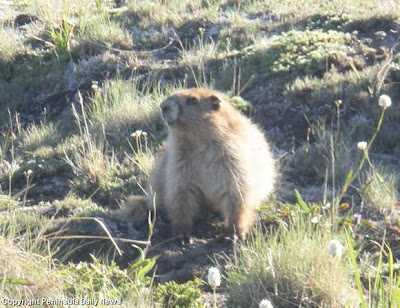I'm through writing this column once I get my new job as a marmot surveyor.
I am uniquely qualified for this position. I have spent years studying the Olympic marmot in an attempt to decipher their language.
It's a series of whistles that are loud enough to make you think the police are coming.
The marmots whistle to warn of predators, defend their burrow complexes against other marmots and make fun of the hordes of granola-crunching backpackers.
The marmots spend the short alpine summer harvesting herbs and grasses, drying them on the scenic front porches of their burrows located high on the mountainside.
Then they spend the long winter, sleeping deep beneath the snow.
Biologists think the number of marmots in Olympic National Park could be depressed by anything from climate change to coyotes.
If the marmots are depressed, they could be endangered. If they aren't endangered, they should be.
Volunteers have been asked to survey the marmots. That could be difficult since the marmots live underground most of the time.
To get an accurate count of the marmots, we may have to borrow a page from the fish surveyors' playbook and electroshock them.
Fortunately, we still have the Elwha River dams for a supply of cheap and reliable electricity. All we need are a few miles of cable and some zircon encrusted electrodes.
We'll run some juice down their holes and see if the marmots don't just scamper out and get counted.
Once we count the marmots, then what?
Methodologies have yet to be developed to ensure we don't count the same marmot twice.
This would be problematic since increased numbers of the marmot would lessen its chances of being endangered.
Sure the marmots are cute, but they all look pretty much the same.
Paint-balling the marmots with a permanent dye to make them easier to identify has been suggested, but weapons are unpopular in Olympic National Park.
Once again we'll take a cue from fisheries management. They cut various fins off the fish to identify them.
The marmots don't have fins, so we'll shave them. Any marmot with a bad haircut means it's already been counted.
Then, we'll attach a radio collar with a webcam to the marmot and see if it can still fit back in its hole.
Any responsible marmot survey would have to include tribal co-management.
Native Americans traditionally hunted marmots for their meat and skins.
Once the survey is completed, harvestable numbers of breeding marmots could be netted and sold to trendy local restaurants and join wild steelhead on the menu.
I know what you're thinking.
What if aggressive survey techniques and a commercial harvest are not successful at making the Olympic marmots endangered?
Time for another fisheries management time-honored tool:
We'll increase the number of predators in the ecosystem until the population of prey species tweaks. That's where the fishers come in.
I can't say for sure that this large member of the weasel family eats marmots, if they don't they should.
While there was no mention of monetary compensation for the marmot surveyors, there was no money in bull trout either — until it was endangered. Now it's worth about a billion dollars a year.
It is my hope that by using a few simple management strategies and study methodologies borrowed from the salmon restoration industry, we could have the marmot declared endangered in my lifetime.
Once something is on the endangered species list, it doesn't matter how it got there. It forces the floodgate for federal funding for further studies.
Those who ignore history are normal.



No comments:
Post a Comment